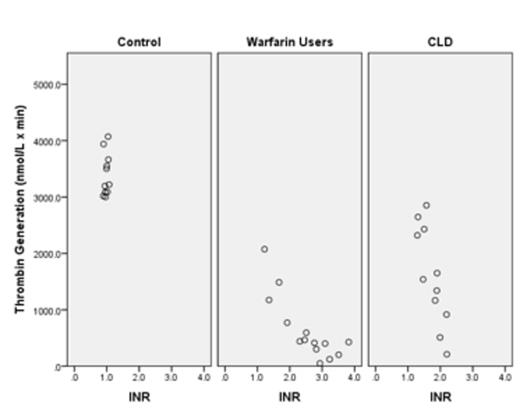Abstract
Introduction
The liver is responsible for the synthesis and clearance of factors involved in the coagulation cascade. Liver fibrosis results in complex alterations in procoagulant and anticoagulant proteins. Although an elevated International Normalized Ratio (INR) is a prominent feature of progressive fibrosis, the utility of the INR to accurately reflect the net effect of these changes on the coagulation system is uncertain. In patients with chronic liver disease (CLD), elevated INRs have been observed in both bleeding and thrombotic complications, suggesting limitations of the INR in characterizing the coagulation status. Unlike the INR, which is preferentially sensitive to the extrinsic pathway, the direct measurement of thrombin generation (TG) is better able to capture the global coagulation cascade. Therefore, our pilot study sought to characterize thrombin generation, chromogenic factor X (cFX) and the INR in CLD subjects and compared them to non-CLD subjects on warfarin anticoagulation.
Methods
We prospectively recruited medically stable subjects seen in the ambulatory setting at a large multiinstitutional academic medical center from March 2013-May 2014. Thirty-four patients were enrolled into the three study groups comprising of control (n=11), non-CLD on warfarin (n=14), and CLD (n=9). Indications for warfarin anticoagulation included atrial fibrillation and venous thromboembolism. TG Assay was performed using the diaPharma technothrombin TGA. INR was determined using the Siemen's Innovin reagent on the BCS-XP instrument. cFX was performed using the diaPharma cFX kit on a BCS-XP instrument. Statistical analysis was performed using SPSS Version 22. Spearman rho correlations (ρ) were utilized to assess relationships between continuous variables. Two-sided P-values (p) <0.05 were considered significant.
Results
INR correlated inversely with cFX in both warfarin (ρ= -0.86, p=<0.001) and CLD (ρ= -0.87,p=0.002) subjects. In Figure 1, the respective cFX activity measured within control, warfarin and CLD subjects ranged from 81-172% (M=119%), 22-93% (M=40%), and 27-80% (M=44%). As validated in previous studies, warfarin subjects with therapeutic lNR (2.0-3.5) had cFX activity between 24-48% (M=35), which corresponded to 20-35% of cFX activity observed in the control group (M=119). In respect to TG, INR also had an inverse correlation in both warfarin (ρ= -0.86, p=<0.001) and CLD (ρ=-0.76, p=0.004) subjects. In Figure 2, TG measured within control, warfarin and CLD subjects ranged from 3000-4072 nmol/L x min (median, M=3220 nmol/L x min), 49-2074 nmol/L x min (M=426 nmol/L x min), and 210-2853 nmol/L x min (M=1539 nmol/L x min) respectively. In warfarin subjects on therapeutic anticoagulation, TG consistently demonstrated diminished levels <600 nmol/L x min. However, relative to warfarin subjects, the measured TG in CLD subjects exhibited a large interquartile range (IQR) across the measured INRs (1700 nmol/L x min vs. 290 nmol/L x min).
Conclusion
This pilot study demonstrates that therapeutic INR ranges in warfarin subjects produce consistent suppression of TG and cFX activity. Furthermore, thrombin generation less than 600 nmol/L x min may represent a clinically relevant equivalent to therapeutic INR in warfarin patients. Lastly in CLD patients, we report greater variability in TG with comparable INR activity. This preliminary finding suggests that INR represents a suboptimal surrogate for TG, which we believe is a superior measure of coagulation function in CLD subjects.
Chromogenic Factor X (cFX) against the International Normalized Ratio (INR) across study groups of control, warfarin, and chronic liver disease (CLD) subjects.
Chromogenic Factor X (cFX) against the International Normalized Ratio (INR) across study groups of control, warfarin, and chronic liver disease (CLD) subjects.
Thrombin Generation (TG) against the International Normalized Ratio (INR) across study groups of control, warfarin, and chronic liver disease (CLD) subjects.
Thrombin Generation (TG) against the International Normalized Ratio (INR) across study groups of control, warfarin, and chronic liver disease (CLD) subjects.
No relevant conflicts of interest to declare.
Author notes
Asterisk with author names denotes non-ASH members.



This feature is available to Subscribers Only
Sign In or Create an Account Close Modal